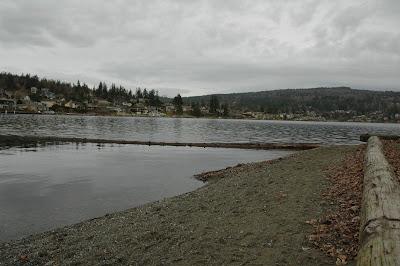 |
| Another gray day on Lake Whatcom Photo by Mikey Jane Moran |
The city has yet to implement rate hikes and the reduction plan is still under consideration by the city council, but water quality in Lake Whatcom continues to be an issue for all of the Bellingham residents who drink it everyday.
“It's a source of water for
almost 100,000 people so it's something we should all pay attention
to,” said Myron Wlaznak, Silver Beach resident and Neighborhood
Association member.
The lake's phosphorus content
is above acceptable levels according to the Department of Ecology,
encouraging algae to grow, which limits the oxygen in the lake and
contaminates the water pouring out of Belingham's taps.
 |
| A sign in Bloedel Donavan tells all Photo by Mikey Jane Moran |
The worth of current
programs
The Silver Beach neighborhood,
which lies on the watershed and adjacent to the lake, has been host
to city projects like the Homeowners Incentive Program. This project
provides grants to residents who re-landscape their property to
minimize runoff and according to the cost-benefit analysis, Silver
Beach will be the target of more programs like this one in the
future.
The city also currently
distributes rain barrels and circulates educational pamphlets through
out the neighborhood to raise awareness of what city programs can
offer residents.
Building designer and Sliver
Beach resident Jan Hayes said the best way to deal with runoff
pollution is to continue to expand these incentive opportunities.
Hayes landscaped her property with the help of the Homeowners
Incentive Program, which payed for the majority of the project.
“I have done what I can on
my property to mitigate my runoff and I am hoping that is significant
enough,” Hayes said.
Wlaznak is less confident in
the effectiveness of existing programs. He said rain barrels often
overflow during heavy rains, spilling rain water back on to the
streets. He thinks small changes like rain gardens are not enough to
bring about necessary improvements and the city is missing out on
mitigating the largest source of runoff: roads.
 |
| Runoff flows onto the beach Photo by Mikey Jane Moran |
“Once phosphorus becomes
soluble,” Wlaznak said, “it is extremely difficult to get it out
through any type of filtering medium.”
He suggests ecologically
conscious roadway programs, such as the one implemented on North
Shore Drive which uses porous pavement so dirty water can be filtered
by soil before reaching the lake. Road retrofits will be a feature of
the city's reduction plan according to the cost-benefit analysis
released by CH2M Hill.
The development debate
Development around the lake is
also a concern and most of the money gathered from the water rate
hike will go to pay for property purchases so land can be preserved
and undeveloped, said Clare Fogelsong, Environmental Resource Manager
for the Bellingham Public Works Department.
“We are looking for the most
return,” said Fogelsong, who explained the city can maximize
phosphorous loading reduction by protecting forested areas around the
lake.
“Any disturbance in the land
adds and contributes to more phosphorus in the lake so development is
one of the big culprits,” Hayes said.
Municipal code prevents land
development in Silver Beach during the rainy season from Oct. 1 to
May 31 every year to limit phosphorous runoff from loose dirt.
The local perspective
Land acquisition is an
important part of the lake's health and Wlaznak could not be a bigger
proponent of the cause, but he also calls for a more hands on
approach from the city. He suggested experienced gardeners talk to
residents while they are working in their yards and offer suggestions
about greener landscaping options.
“I think people will respond
more to that than to getting a regulation crammed down their
throats,” said Wlaznak, who advocated the city work more locally.
“I think the city's approach
really needs to be much more interactive with the people, they need
to get to know the people,” he said. “I can't tell you how many
violations of the watershed rules happen on the weekends and
unfortunately the city works nine to five.”
Fogelsong said that the city
also hopes to have a more local focus and is “gearing up” it's
employees to serve the community better.
“We have spent many years
distributing fliers and mailers, and we were just not pleased with
the results,” said Fogelsong, emphasizing the city's shift to more
involved strategies. He said residents can expect to see more city
officials conversing with individuals in the months to come.
But residents must also step
up and do their part to limit phosphorus run-off, Hayes said.
 |
| A sign presents a call to action in the park Photo by Mikey Jane Moran |
Even with the lake in their
front yard, many citizens are unaware of lake pollution issues.
Boater and resident of Silver Beach, Alan Lipp, said he doubts
community members understand the dangers of phosphorous in the lake.
“I don't know if [residents]
know if there is a problem at all,” said Lipp while boating in
Bloedel Donovan Park. “I just went to set my boat down and there is
dog poop right there by the water.”
Because phosphorous is not
visible like other forms of pollution, it can go unnoticed.
“Unfortunately, you can look
at the water now and you can't see the problems,” said Wlaznak,
though the issue still persists however unseen.
No comments:
Post a Comment